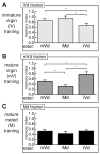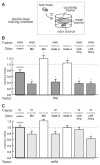Generalization of courtship learning in Drosophila is mediated by cis-vaccenyl acetate
- PMID: 17363250
- PMCID: PMC1913718
- DOI: 10.1016/j.cub.2007.01.053
Generalization of courtship learning in Drosophila is mediated by cis-vaccenyl acetate
Abstract
Reproductive behavior in Drosophila has both stereotyped and plastic components that are driven by age- and sex-specific chemical cues. Males who unsuccessfully court virgin females subsequently avoid females that are of the same age as the trainer. In contrast, males trained with mature mated females associate volatile appetitive and aversive pheromonal cues and learn to suppress courtship of all females. Here we show that the volatile aversive pheromone that leads to generalized learning with mated females is (Z)-11-octadecenyl acetate (cis-vaccenyl acetate, cVA). cVA is a major component of the male cuticular hydrocarbon profile, but it is not found on virgin females. During copulation, cVA is transferred to the female in ejaculate along with sperm and peptides that decrease her sexual receptivity. When males sense cVA (either synthetic or from mated female or male extracts) in the context of female pheromone, they develop a generalized suppression of courtship. The effects of cVA on initial courtship of virgin females can be blocked by expression of tetanus toxin in Or65a, but not Or67d neurons, demonstrating that the aversive effects of this pheromone are mediated by a specific class of olfactory neuron. These findings suggest that transfer of cVA to females during mating may be part of the male's strategy to suppress reproduction by competing males.
Figures




Comment in
-
Mate recognition: should fly stay or should fly go?Curr Biol. 2007 Apr 3;17(7):R240-2. doi: 10.1016/j.cub.2007.02.014. Curr Biol. 2007. PMID: 17407751
Similar articles
-
Love makes smell blind: mating suppresses pheromone attraction in Drosophila females via Or65a olfactory neurons.Sci Rep. 2014 Nov 19;4:7119. doi: 10.1038/srep07119. Sci Rep. 2014. PMID: 25406576 Free PMC article.
-
The Drosophila pheromone cVA activates a sexually dimorphic neural circuit.Nature. 2008 Mar 27;452(7186):473-7. doi: 10.1038/nature06808. Epub 2008 Feb 27. Nature. 2008. PMID: 18305480
-
A single class of olfactory neurons mediates behavioural responses to a Drosophila sex pheromone.Nature. 2007 Mar 29;446(7135):542-6. doi: 10.1038/nature05672. Nature. 2007. PMID: 17392786
-
Pleiotropic actions of the male pheromone cis-vaccenyl acetate in Drosophila melanogaster.J Comp Physiol A Neuroethol Sens Neural Behav Physiol. 2015 Sep;201(9):927-32. doi: 10.1007/s00359-015-1020-9. Epub 2015 Jun 24. J Comp Physiol A Neuroethol Sens Neural Behav Physiol. 2015. PMID: 26105507 Free PMC article. Review.
-
Odor and pheromone detection in Drosophila melanogaster.Pflugers Arch. 2007 Aug;454(5):749-58. doi: 10.1007/s00424-006-0190-2. Epub 2007 Jan 5. Pflugers Arch. 2007. PMID: 17205355 Review.
Cited by
-
A dopamine-gated learning circuit underpins reproductive state-dependent odor preference in Drosophila females.Elife. 2022 Sep 21;11:e77643. doi: 10.7554/eLife.77643. Elife. 2022. PMID: 36129174 Free PMC article.
-
Molecular social interactions: Drosophila melanogaster seminal fluid proteins as a case study.Adv Genet. 2009;68:23-56. doi: 10.1016/S0065-2660(09)68002-0. Epub 2010 Jan 13. Adv Genet. 2009. PMID: 20109658 Free PMC article.
-
Sex Pheromone Mediates Resource Partitioning Between Drosophila melanogaster and D. suzukii.Evol Appl. 2024 Nov 11;17(11):e70042. doi: 10.1111/eva.70042. eCollection 2024 Nov. Evol Appl. 2024. PMID: 39534538 Free PMC article.
-
Regulation of Drosophila Long-Term Courtship Memory by Ecdysis Triggering Hormone.Front Neurosci. 2021 Apr 22;15:670322. doi: 10.3389/fnins.2021.670322. eCollection 2021. Front Neurosci. 2021. PMID: 33967686 Free PMC article.
-
Loss of Drosophila pheromone reverses its role in sexual communication in Drosophila suzukii.Proc Biol Sci. 2015 Apr 7;282(1804):20143018. doi: 10.1098/rspb.2014.3018. Proc Biol Sci. 2015. PMID: 25716789 Free PMC article.
References
-
- Tompkins L, Siegel RW, Gailey DA, Hall JC. Conditioned courtship in Drosophila and its mediation by association of chemical cues. Behav Genet. 1983;13:565–578. - PubMed
-
- Wicker C, Jallon JM. Hormonal control of sex pheromone biosynthesis in Drosophila melanogaster. J Insect Physiol. 1995;41:65–70.
-
- Savarit F, Ferveur JF. Temperature affects the ontogeny of sexually dimorphic cuticular hydrocarbons in Drosophila melanogaster. J Exp Biol. 2002;205:3241–3249. - PubMed
Publication types
MeSH terms
Substances
Grants and funding
LinkOut - more resources
Full Text Sources
Other Literature Sources
Molecular Biology Databases

